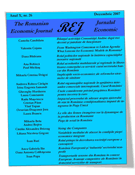Abstract:
Remittances constitute an important source of foreign capital for developing countries. It has the potential to smooth consumption and stimulate investment and welfare among recipient countries. Countries of West Africa Monetary Zones (WAMZ) have experienced increased receipt of migrant remittances and paradoxically slow economic growth performance. In this study, we empirically investigated the short-run and long-run impacts of migrant remittance on economic growth performance for WAMZ. Panel secondary data from World Bank and International Monetary Fund for the period 1990-2016 were used for the analysis. Descriptive statistics and Pooled Mean Group (PMG) estimator were used for the analysis. The result showed significant short-run and long-run growth effects of remittances in the WAMZ. In the short-run, remittance has positive relationship with real per capital gross domestic product, but in the long-run the relationship becomes negative which may be due to the fact that remittances were not expended on investment projects, it breeds laziness, intensify income inequalities and causes significant brain drain. Short-run determinants of economic growth among countries of WAMZ were human capital and trade openness. Determinants of long-run economic growth among countries of WAMZ were labour, capital formation, human capital, trade openness and interest rate. The study recommends that a large portion of remittances should be channeled to profitable investments. To this end, the government should provide the enabling environment necessary for business to thrive.
